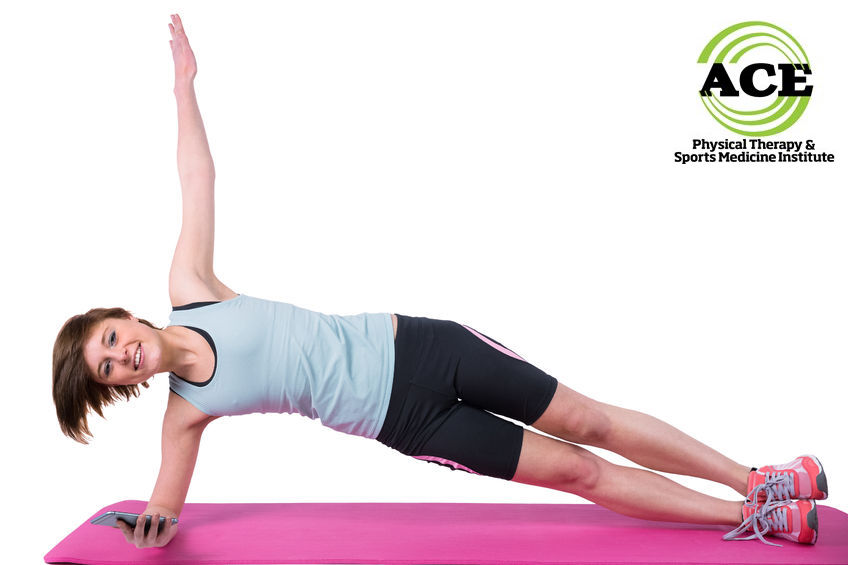CORE STRENGTH AND PHYSICAL THERAPY

Tid Bits of Info
- 90 – 95% of the population will experience low back pain at some time in their life.
- Sit ups can be detrimental and cause more low back pain.
- Core muscles are predominately slow twitch fibers and need to trained to be “marathoners”.
- Seek the advice and treatment of a Physical Therapist if you get injured or are attempting to prevent an injury.
Core strength is vital for the essential support that helps you avoid injuries while moving in a variety of activities. Over the last decade, more and more fitness programs and literature have focused on the importance of developing core muscles. What is the core? How do you build and measure core strength? Your Physical Therapist can help you assess your core stability, and here are exercises that can help build your core strength.
The core muscles are located on your torso. The anterior muscles of stomach area, the lateral muscles along your side and the muscles that course along the spine. The rectus abdominus, transversus abdominus, internal and external obliques and erector spinae muscles are the primary muscles of the core. Many healthcare professionals consider any muscle that “attaches” to the pelvis, ribs or spine from the chest to the knees as part of the core, but the “official” core muscles are those that are mentioned previously.
Physical therapists and other healthcare professionals spend a large part of their day treating patients with poor core strength, endurance and control. They struggle to put a definitive, objective value on the status of these muscles, but one quick and easy method is the McGill core endurance test. The test is a timed value for muscular endurance in four different positions aimed at testing the core muscles. The positions are held for as long as the patient can maintain proper form. The test consists of anterior trunk flexor test, side planks and posterior trunk extensor test.
The Physical Therapist can use the data obtained by a simple test such as the McGill core endurance test and develop a treatment protocol that will enhance the strength, endurance and control of the core muscles. Recent research has shown that the core muscles are the “foundation” of all movement throughout the body. The lack of strength, muscular endurance and neuromuscular control of the core muscles can lead to injuries and decreased function in other body parts.
The following are simple exercises that will address core weakness. By performing them on a daily basis and doing 30 -45 repetitions of each exercise correctly, you can develop strength, muscular endurance and core control or enhanced neuromuscular activity. Plan to continue these exercises for a lifetime for best results, but you might have to exercise consistently for 6-8 weeks before you experience a significant improvement.
EXERCISES:
1. Superman: Lie prone (on your stomach) with your arms outstretched overhead. Slowly raise one arm and the opposite leg. Pause and then lower the arm and leg down.
2. Bridge: Lie on your back (supine) and bend your knees, so your feet are flat on the floor. Contract your stomach muscles and try to move your belly button towards the floor. Slowly raise your buttocks off of the floor. Pause for 2 seconds at the top and be as still/stable as possible.
3. Plank: Lie prone (on your stomach) and push yourself up off of the floor. Support your body weight on your forearms, elbows and toes. No other body part should touch the floor during the exercise. If it is too hard to support your body weight this way, you may allow your knees to touch the floor. The position should be held for 5-30 seconds or longer.
4. Side Plank: Lie on one side. Push your body weight up off of the floor and support it with our forearm and elbow on the side where you are lying. The side of your foot rests on the floor during the exercise routine. If this position is too difficult, keep the entire side of your leg below the knee on the floor during the exercise. Hold the position 5-30 seconds or longer.
The core musculature is probably the most important musculature of the body. It has the ability to support the spine and pelvis adequately to allow motion throughout the joints of the body. Without proper support the movement throughout the body is limited and many times performed with numerous compensatory actions that can lead to injuries.
Seek the advice of a Physical Therapist for the proper exercises to perform to fully develop the core muscles. You can walk-in to a Physical Therapy center for evaluation and treatment without seeing your doctor first. The therapist will provide you with a thorough exercise routine that will help to resolve your symptoms and fix the problem of a weak or deconditioned core.

























